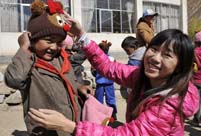Milestones of Tibet's development and progress
The founding of the People's Republic of China in 1949 opened up new prospects for the nation's development and progress on an unprecedented level. In 1951, the Central People's Government and the local Tibetan government signed the Agreement on Measures for the Peaceful Liberation of Tibet, signifying the beginning of Tibet's development and progress together with the people of the whole nation.
The year 1959 marked a turning point in Tibet's history. In that year the reactionary upper ruling strata of Tibet failed in an armed rebellion to perpetuate feudal serfdom, and the Central Government publicly announced the dismissal of the Tibetan local government. Meanwhile the people of all ethnic groups in Tibet launched a sweeping democratic reform to overthrow Tibet's feudal serfdom system under theocracy that had been in place for hundreds of years, ushering in a social reform that was considered the most extensive, profound and progressive in Tibetan history. The democratic reform liberated about a million serfs and slaves, and brought the basic human rights of equity and freedom to the Tibetan people for the first time in history. It laid the necessary economic, political and social foundation for the region' s future development and progress.
In 1965, the Tibet Autonomous Region was founded, and the systems of the people's congress and regional ethnic autonomy were established. These events marked the leap forward for Tibetan society from a feudal serfdom under theocracy to socialism, with the people becoming their own masters. With the establishment of the new political system and the dissemination of ideas on democratic politics, the former serfs and slaves as well as the feudal aristocrats all became modern citizens who enjoy equal rights and exercise their political rights to equally participate in the management of state affairs and the affairs of their local ethnic groups autonomously. In this way, the Tibetan people were greatly motivated to use their enthusiasm and creativity to build a better future.
At the end of 1978, Tibet initiated the reform and opening-up drive toward modernization along with the rest of the country, ushering in a new stage of economic and social development. The Central Government set lofty goals for Tibet, striving to quicken its development and advancing it to the front row of the "four modernizations." In light of the local conditions, the government decided on guiding principles for the work in Tibet in the new era and issued favorable policies for Tibet's development. These moves vigorously contributed to the development and progress in Tibet.
In the 21st century, Tibet has entered the fast lane of development. At the Fifth Symposium on Work in Tibet held in January 2010, the Central Authorities set the goals for Tibet's development in the next stage. The objectives for 2015 are to maintain the pace of leapfrog economic development, significantly narrow the gap between the per capita net income of farmers and herdsmen in Tibet and the national average, significantly increase Tibet's ability to provide public services, further improve the ecosystem, greatly develop Tibet's infrastructure, achieve unity and harmony among all ethnic groups, maintain social stability, and make a more solid foundation for building a moderately prosperous society in all respects. The objectives set for 2020 are to raise the per capita net income of farmers and herdsmen in Tibet so that it will be close to the national average, comprehensively raise the living standards of the people, improve its basic public services to approach the national average level, comprehensively improve infrastructure conditions, achieve significant results in creating an ecological security screen, greatly increase Tibet's capabilities for self-development, make Tibetan society more harmonious and stable, and ensure that a moderately prosperous society in all respects is established. With these goals achieved, better prospects for development will emerge in Tibet.
【11】 【12】 【13】 【14】 【15】 【16】 【17】 【18】 【19】 【20】
【21】 【22】 【23】


 No news of survivors in Lao Airlines crash
No news of survivors in Lao Airlines crash Five fighters in flight training
Five fighters in flight training London mayor hails free trade, subway system on China tour
London mayor hails free trade, subway system on China tour Different eye catching shows at housing fairs in China
Different eye catching shows at housing fairs in China Chalk it up to great courage
Chalk it up to great courage Tibetan girl helps mobilize volunteers onlin
Tibetan girl helps mobilize volunteers onlin Lingerie show dazzles Wuhan Motor Show 2013
Lingerie show dazzles Wuhan Motor Show 2013  Chinese screen goddesses from Beijing Film Academy
Chinese screen goddesses from Beijing Film Academy  Weekly Sports Photos
Weekly Sports Photos Bayi Parachute Team of PLA Air Force
Bayi Parachute Team of PLA Air Force World has never been dark-- a blind kid’s life in Tibet
World has never been dark-- a blind kid’s life in Tibet Change to law may make it easier to sue polluters
Change to law may make it easier to sue polluters UNESCO world heritage site: Montale Tower
UNESCO world heritage site: Montale Tower U.S. Senate leader announces bipartisan deal
U.S. Senate leader announces bipartisan deal Fiber-optic wedding dress show shinning in Suzhou
Fiber-optic wedding dress show shinning in Suzhou Day|Week|Month